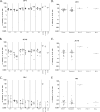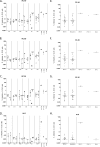Donor and recipient envs from heterosexual human immunodeficiency virus subtype C transmission pairs require high receptor levels for entry
- PMID: 20147398
- PMCID: PMC2849512
- DOI: 10.1128/JVI.02068-09
Donor and recipient envs from heterosexual human immunodeficiency virus subtype C transmission pairs require high receptor levels for entry
Abstract
Compact, glycan-restricted envelope (Env) glycoproteins are selected during heterosexual transmission of subtype C HIV-1. Donor and recipient glycoproteins (Envs) from six transmission pairs were evaluated for entry into HeLa cells expressing different levels of CD4 and CCR5. Donor and recipient Envs demonstrated efficient entry into cells expressing high levels of CD4 and CCR5, and entry declined as CCR5 levels decreased. Infectivity for all Envs was severely impaired in cells expressing low levels of CD4, even at the highest CCR5 levels. In 5/6 pairs, there was no significant difference in efficiency of receptor utilization between the donor and recipient Envs in these HeLa-derived cell lines. Thus, HIV-1 transmission does not appear to select for viruses that can preferentially utilize low levels of entry receptors.
Figures


References
-
- Cecilia, D., S. S. Kulkarni, S. P. Tripathy, R. R. Gangakhedkar, R. S. Paranjape, and D. A. Gadkari. 2000. Absence of coreceptor switch with disease progression in human immunodeficiency virus infections in India. Virology 271:253-258. - PubMed
-
- Chohan, B., D. Lang, M. Sagar, B. Korber, L. Lavreys, B. Richardson, and J. Overbaugh. 2005. Selection for human immunodeficiency virus type 1 envelope glycosylation variants with shorter V1-V2 loop sequences occurs during transmission of certain genetic subtypes and may impact viral RNA levels. J. Virol. 79:6528-6531. - PMC - PubMed
-
- Derdeyn, C. A., J. M. Decker, F. Bibollet-Ruche, J. L. Mokili, M. Muldoon, S. A. Denham, M. L. Heil, F. Kasolo, R. Musonda, B. H. Hahn, G. M. Shaw, B. T. Korber, S. Allen, and E. Hunter. 2004. Envelope-constrained neutralization-sensitive HIV-1 after heterosexual transmission. Science 303:2019-2022. - PubMed
Publication types
MeSH terms
Substances
Grants and funding
LinkOut - more resources
Full Text Sources
Medical
Research Materials

